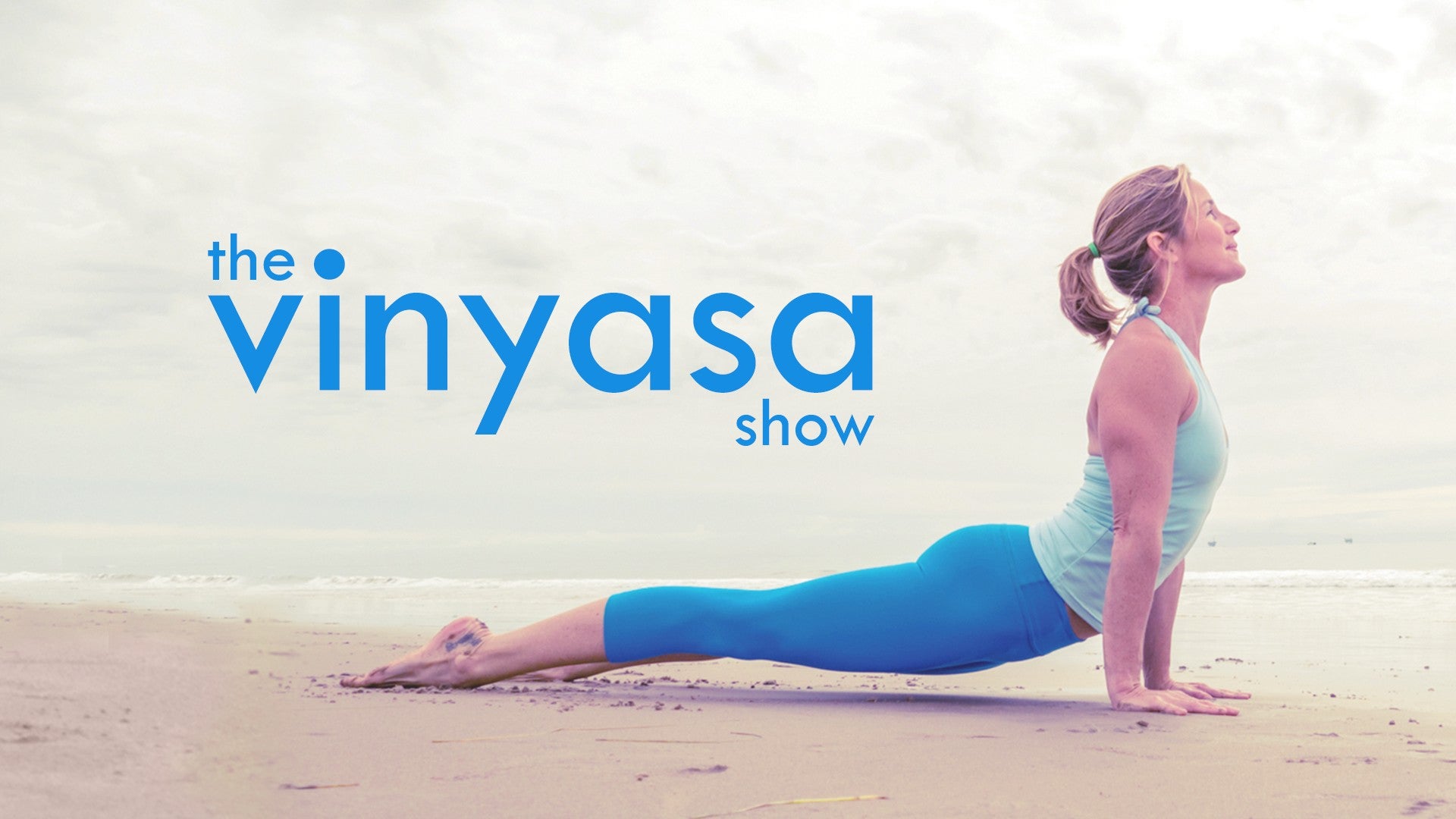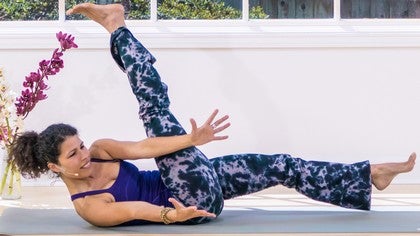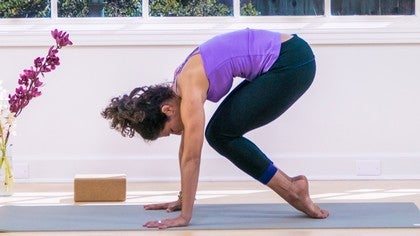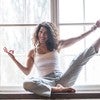Description
About This Video
Transcript
Read Full Transcript
(waves splash) Hello. We're gonna be looking at the core and what the core is about, and how we connect to it. So, my experience is that, when we speak of core, we work out the core, what we're talking about is the visual part of core, you know. But what we will be working with here is more the deeper layers of core, which is the stability part of it. So we're held together by our core, and that would mean that we're connecting to the transversus muscle, which doesn't show, and it doesn't do much movement because its purpose is to hold us together, to keep us tall.
We'll also be looking at, or more feeling at the iliopsoas, which is a major component of two muscles that starts in the lower back and connects to your thigh bones. So what will we be working with? So we need something to guide us, so we'll be working with the hip points. If you take your hands to the front of your hips, you have two knobby shaped bones. And these bones will be attracted to each other.
So we're trying to get them attracted towards the middle. And once you do that, you could do that right now, just standing here on the knees, even standing on your feet if you like to, if you take these bones in towards the midline, it's hardly movable, you don't see it, I can't see you doing anything, but you feel it. And also, drawing in towards the middle, towards your navel, keep that, and lift your pelvic floor just slightly, slightly. So maybe now you get the sensation of contraction. This is what we'll be working with lying down.
So get yourself down on your mat. Start with your knees bent, feet to the floor. Now, by the way, starting in this position, this is called constructive rest pose, this is very nice and relaxing for your psoas because actually, your psoas is not doing anything right now, it's just settling. (exhales) So just start here for a little while, breathe. You could place your hands somewhere on the front of your body, just to connect to your breath for a little while. So the best starting point to work with anything, really, is from a relaxed starting point.
So from here, straighten out your legs. I'm gonna put down my arm to the side because that makes me a little bit more relaxed, although I will be talking with my hand a little. So just notice the tendencies of what your feet are doing, notice what your feet are doing. So, for most of us, they roll out, which is, by the way, called an outer rotation, we're gonna be looking at that later. So the first thing we do, we're gonna be connecting to the transversus, you know, the one that we were looking at when we drew our hip points in towards the middle.
Toes pointing up, so you'll have to create an inner rotation. So from the feet lying out towards the sides, you'll create a little small inner rotation, and the feet point up. So this is like you're standing on your feet. So imagine you're standing on your feet. I like to spread my toes.
So spread your toes, it gets a little bit more, mmm, muscular, more integrity into the feet, into the legs. So just notice, did anything happen? Do you notice any change? And something we have to do the reverse to know what's going on, do the opposite. Let your feet just go again.
And turn your toes again, up towards the ceiling, like you're standing on them, so maybe you pushed 'em away just slightly. This will create a little arch in the back. This is your natural arch. So we're not overdoing it, it's just that, as soon as we create some muscular energy into the legs, we're gonna be drawing the back of our hips down towards the earth, just gently. Now from here, spreading the toes, feet open and wide, imagine, we're not gonna be moving anything, really, but imagine you're lifting both legs off the floor.
And release. Let's do that with breath. Inhale, lift your legs off the floor, but only in your imagination. Exhale, release. (exhales) Again, you feel that. Inhale, lift the feet off the floor, they're not really lifting, but your mind is lifting them, and you're feeling it, deeply in your core.
Release. So relax your legs, let them fall out. Let's do this again, toes pointing up, imagine you're standing on your feet. Engage your hip bones in towards each other. Gently lift the pelvis.
We didn't say this before lying down 'cause we were just imagining the lift, but do this, hips in towards the middle, pelvis lifting up towards the navel, gently, this is just a small, small, small action, and lift the legs off the ground without actually lifting the legs off the ground. And release. (exhales) That's a lotta work. So just settle, relax. We're going to be doing the same thing again, and we will lift the leg, one leg at a time. So stand up again, we're imagining we're standing up.
Spread the toes. So let's take the right leg first. Arms to the side if you're not talking with the hand. Very gently, lift the right leg off the floor, just like small, small, small space off the floor, and back. And again, inhale, lift, toes pointing up.
Exhale release. (exhales) One more time. Notice where you're feeling the action, and release. Other side. Inhale, lift one leg, exhale, release. (exhales) Again, and release. Now you don't really need much movement.
It just takes a little bit. And down again. (exhales) Great, just relax, couple breaths here. Notice the effects. We'll do this one last time. The different this time, though, is that we're gonna do a slight outer rotation on the leg we're lifting before we lift.
So start with both feet parallel, toes pointing up towards the sky. I like to spread my toes. So from here, let's start with the right leg, turn your toes slightly out, and lift. Again, very small movement, and down. See if you notice any change.
Lift, and down. (exhales) Inhale, exhale. Feet parallel again, other side, slight outer rotation on your left leg, inhale, lift, exhale, release. (exhales) Inhale, lift, exhale. (exhales) So one last time, inhale, lift, exhale, release. So just settle for a little while. If you'd like to do this more, do the whole sets of movements that we've done. First, we started with toes pointing up, lifting the legs in our imagination.
Just feel into that. Where do you feel the movements? Where do you feel the action? What's going on? And then, we did a slight outer rotation, no, first we lifted one leg up without the outer rotation.
Third, it was the outer rotation, and we lifted. So for me, and I think maybe for you, you'll feel the psoas in the back once you do the outer rotation, and lift, just try to notice. It could take some time to get into this. It could take some time to notice what happens in your body. So I'm getting up now.
If you wanna lay down and stay down for a little while, do so, and we'll see you in the next clip.
The Vinyasa Show: Alexandra Kambler
Comments
You need to be a subscriber to post a comment.
Please Log In or Create an Account to start your free trial.












 ! New experience for me that is used to core training with traditional "sit ups"
! New experience for me that is used to core training with traditional "sit ups" 



